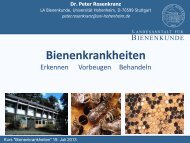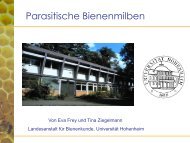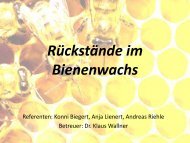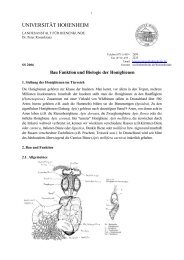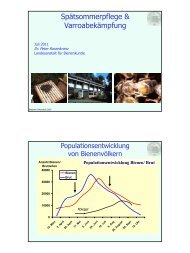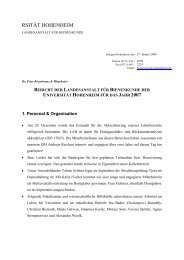Nosema ceranae in European honey bees - Landesanstalt für ...
Nosema ceranae in European honey bees - Landesanstalt für ...
Nosema ceranae in European honey bees - Landesanstalt für ...
You also want an ePaper? Increase the reach of your titles
YUMPU automatically turns print PDFs into web optimized ePapers that Google loves.
S78 I. Fries / Journal of Invertebrate Pathology 103 (2010) S73–S79<br />
The impact of N. <strong>ceranae</strong> <strong>in</strong>fections on the development of A.<br />
cerana colonies also needs to be <strong>in</strong>vestigated. There is presently a<br />
grow<strong>in</strong>g <strong>in</strong>terest <strong>in</strong> A. cerana beekeep<strong>in</strong>g both for conservation purposes<br />
and because this species of <strong>honey</strong> bee has some advantages<br />
compared to A. mellifera, such as tolerance to the mites Varroa<br />
destructor and Tropilaelaps clareae. An <strong>in</strong>creased understand<strong>in</strong>g of<br />
how N. <strong>ceranae</strong> <strong>in</strong>vades its presumed orig<strong>in</strong>al host, and how A. cerana<br />
resists or tolerates such <strong>in</strong>vasions, will therefore be of <strong>in</strong>terest<br />
for these species and, by <strong>in</strong>ference, A. mellifera.<br />
Conflicts of <strong>in</strong>terest<br />
There are no conflicts of <strong>in</strong>terest to be declared.<br />
Acknowledgements<br />
Helpful comments on the manuscript by Jay Evans are highly<br />
appreciated.<br />
References<br />
Antúnez, K., Mart<strong>in</strong>-Hernandez, R., Prieto, L., Meana, A., Zun<strong>in</strong>o, P., Higes, M., 2009.<br />
Immune suppression <strong>in</strong> the <strong>honey</strong> bee (Apis mellifera) follow<strong>in</strong>g <strong>in</strong>fection by<br />
<strong>Nosema</strong> <strong>ceranae</strong> (Microsporidia). Environ. Microbiol.. doi:10.1111/j.1462-<br />
2920.2009.01953x.<br />
Bailey, L., 1955. The epidemiology and control of <strong>Nosema</strong> disease of the <strong>honey</strong>-bee.<br />
Ann. Appl. Biol. 43, 379–389.<br />
Bailey, L., 1962. Bee diseases. Rep. Rothamstad exp. Stan. 1961, 16–161.<br />
Bailey, L., 1967. <strong>Nosema</strong> apis and dysentery of the <strong>honey</strong>bee. J. Apic. Res. 6, 121–125.<br />
Bailey, L., 1981. Honey Bee Pathology, second ed. Academic Press, London.<br />
Borchert, A., 1928. Beiträge zur Kenntnis der Bienen Parasiten <strong>Nosema</strong> apis. Archive<br />
<strong>für</strong> Bienenkunde 9, 115–178.<br />
Chen, Y., Evans, J.D., Smith, I.B., Pettis, J.S., 2008. <strong>Nosema</strong> <strong>ceranae</strong> is a long-present<br />
and wide-spread microsporidean <strong>in</strong>fection of the <strong>European</strong> <strong>honey</strong> bee (Apis<br />
mellifera) <strong>in</strong> the United States. J. Invertebr. Pathol. 97, 186–188.<br />
Chen, Y.P., Evans, J.D., Murphy, C., Gutell, R., Zuker, M., Gundensen-R<strong>in</strong>dal, D., Pettis,<br />
J.S., 2009. Morphological, molecular, and phylogenetic characterization of<br />
<strong>Nosema</strong> <strong>ceranae</strong>, a microsporidian parasite isolated from the <strong>European</strong> <strong>honey</strong><br />
bee, Apis mellifera. J. Eukar. Microbiol. 56, 142–147.<br />
Cornman, R.S., Street, C., Chen, Y., Zhao, Y., Schatz, M., Salzberg, S., Egholm, M.,<br />
Hutch<strong>in</strong>son, S., Pettis, J.P., Lipk<strong>in</strong>, W.I., Evans, J.D., 2009. Genomic analyses of the<br />
microsporidian <strong>Nosema</strong> <strong>ceranae</strong>, an emerg<strong>in</strong>g parasite of <strong>honey</strong> <strong>bees</strong>. PLoS<br />
Pathogens. 5, e1000466. doi: 10.1371/journal.ppat.1000466.<br />
Cox-Foster, D.L., Conlan, S., Holmes, E.C., Palacios, G., Evans, J.D., Moran, N.A., Quan,<br />
P.-L., Briese, T., Hornig, M., Geiser, D.M., Mart<strong>in</strong>son, V., vanEngelsdorp, D.,<br />
Kalkste<strong>in</strong>, A.L., Drysdale, A., Hui, J., Zhai, J.H., Cui, L.W., Hutchison, S.K., Simons,<br />
J.F., Egholm, M., Pettis, J.S., Lipk<strong>in</strong>, W.I., 2007. A metagenomic survey of<br />
microbes <strong>in</strong> <strong>honey</strong> bee colony collapse disorder. Science 318, 283–287.<br />
Craig, A.G., Trenczek, T., Fries, I., Bennich, H., 1989. Mass spectrometric identification<br />
of peptides present <strong>in</strong> immunized and parasitized hemolymph from <strong>honey</strong><strong>bees</strong><br />
without purification. Biochem. Biophys. Res. Comm. 165, 637–643.<br />
Darwish, A., Weidner, E., Fuxa, J.R., 1989. Vairimorpha necatrix <strong>in</strong> adipose cells of<br />
Trichoplusia ni. J. Protozool. 36, 308–311.<br />
Deredec, A., Courchamp, F., 2003. Ext<strong>in</strong>ction thresholds <strong>in</strong> host–parasite dynamics.<br />
Ann. Zool. Fennici 40, 115–130.<br />
Doull, K.M., Cellier, K.M., 1961. A survey of the <strong>in</strong>cidence of <strong>Nosema</strong> disease (<strong>Nosema</strong><br />
apis Zander) <strong>in</strong> <strong>honey</strong> bee <strong>in</strong> South Australia. J. Insect Pathol. 3, 280–288.<br />
Faucon, J.P., 2005. La nosémose. La santé de l’Abeille 209, 343–367.<br />
Fries, I., 1988. Infectivity and multiplication of <strong>Nosema</strong> apis Z. <strong>in</strong> the ventriculus of<br />
the <strong>honey</strong> bee. Apidologie 19, 319–328.<br />
Fries, I., 1997. Protozoa. In: Morse, R.A., Flottum, K. (Eds.), Honey Bee Pests, Predators<br />
and Diseases, third ed. A.I. Root Company, Med<strong>in</strong>a, Ohio, USA, pp. 59–76.<br />
Fries, I., Camaz<strong>in</strong>e, S., 2001. Implications of horizontal and vertical pathogen<br />
transmission for <strong>honey</strong> bee epidemiology. Apidologie 32, 199–214.<br />
Fries, I., Feng, F., 1995. Cross<strong>in</strong>fectivity of <strong>Nosema</strong> apis <strong>in</strong> Apis mellifera and Apis<br />
cerana. In: Proceed<strong>in</strong>gs of the Apimondia 34th International Apicultural<br />
Congress. Bucharest, Romania, pp. 151–155.<br />
Fries, I., Forsgren, E., 2008. Undersökn<strong>in</strong>g av spridn<strong>in</strong>gen av <strong>Nosema</strong> <strong>ceranae</strong> i<br />
Sverige. Investigation of the distribution of <strong>Nosema</strong> <strong>ceranae</strong> <strong>in</strong> Sweden<br />
Bitidn<strong>in</strong>gen 107, januari/februari, pp. 26–27 (<strong>in</strong> Swedish).<br />
Fries, I., Forsgren, E., 2009. <strong>Nosema</strong> <strong>ceranae</strong> fungerar <strong>in</strong>te som <strong>Nosema</strong> apis. <strong>Nosema</strong><br />
<strong>ceranae</strong> does not function as <strong>Nosema</strong> apis. Bitidn<strong>in</strong>gen 107, juni, pp. 20–21 (<strong>in</strong><br />
Swedish).<br />
Fries, I., Ra<strong>in</strong>a, S., 2003. American foulbrood (Paenibacillus larvae larvae) and African<br />
<strong>honey</strong> <strong>bees</strong> (Apis mellifera scutellata). J. Econ. Entomol. 96, 1641–1646.<br />
Fries, I., Granados, R.R., Morse, R.A., 1992. Intracellular germ<strong>in</strong>ation of spores of<br />
<strong>Nosema</strong> apis Z. Apidologie 23, 61–71.<br />
Fries, I., Feng, F., da Silva, A., Slemenda, S.B., Pieniazek, N.J., 1996. <strong>Nosema</strong> <strong>ceranae</strong> n.<br />
Sp. (Microspora, <strong>Nosema</strong>tidae), morphological and molecular characterization<br />
of a microsporidian parasite of the Asian <strong>honey</strong> bee Apis cerana (Hymenoptera,<br />
Apidae). Europ. J. Protistol. 32, 356–365.<br />
Fries, I., de Ruijter, A., Paxton, R.J., da Silva, A.J., Susan, B., Slemenda, S.B., Norman, J.,<br />
Pieniazek, N.J., 2001. Molecular characterization of <strong>Nosema</strong> bombi<br />
(Microsporidia: <strong>Nosema</strong>tidae) and a note on its sites of <strong>in</strong>fection <strong>in</strong> Bombus<br />
terrestris (Hymenoptera: Apoidea). J. Apic. Res. 40, 91–96.<br />
Fries, I., Martín, R., Meana, A., García-Palencia, P., Higes, M., 2006a. Natural<br />
<strong>in</strong>fections of <strong>Nosema</strong> <strong>ceranae</strong> <strong>in</strong> <strong>European</strong> <strong>honey</strong> <strong>bees</strong>. J. Apic. Res. 45, 230–<br />
233.<br />
Fries, I., L<strong>in</strong>dström, A., Korpela, S., 2006b. Vertical transmission of American<br />
foulbrood (Paenibacillus larvae) <strong>in</strong> <strong>honey</strong> <strong>bees</strong> (Apis mellifera). Vet. Microbiol.<br />
114, 269–274.<br />
Gatehouse, H.S., Malone, L.A., 1998. The ribosomal RNA gene region of <strong>Nosema</strong> apis<br />
(Microspora): DNA sequence for small and large subunit rRNA genes and<br />
evidence of a large tandem repeat unit size. J. Invertebr. Pathol. 71, 97–105.<br />
Giersch, T., Berg, T., Galea, F., Hornitzky, M., 2009. <strong>Nosema</strong> <strong>ceranae</strong> <strong>in</strong>fects <strong>honey</strong><br />
<strong>bees</strong> (Apis mellifera) and contam<strong>in</strong>ates <strong>honey</strong> <strong>in</strong> Australia. Apidologie 40, 117–<br />
123.<br />
Hassane<strong>in</strong>, M.H., 1953. The <strong>in</strong>fluence of <strong>in</strong>fection with <strong>Nosema</strong> apis on the activities<br />
and longevity of worker <strong>honey</strong> bee. Ann. Appl. Biol. 40, 418–423.<br />
Higes, M., Martín, R., Meana, A., 2006. <strong>Nosema</strong> <strong>ceranae</strong>, a new microsporidian<br />
parasite <strong>in</strong> <strong>honey</strong><strong>bees</strong> <strong>in</strong> Europe. J. Invertebr. Pathol. 92, 81–83.<br />
Higes, M., Garcia-Palencia, P., Mart<strong>in</strong>-Hernandez, R., Meana, A., 2007. Experimental<br />
<strong>in</strong>fection of Apis mellifera <strong>honey</strong><strong>bees</strong> with <strong>Nosema</strong> <strong>ceranae</strong> (Microsporidia). J.<br />
Invertebr. Pathol. 94, 211–217.<br />
Higes, M., Martín-Hernandez, R., Botias, C., Bailon, E.G., Gonzales-Porto, A., Barrios,<br />
L., del Nozal, M.J., Palencia, P.G., Meana, A., 2008a. How natural <strong>in</strong>fection by<br />
<strong>Nosema</strong> <strong>ceranae</strong> causes <strong>honey</strong>bee colony collapse. Environ. Microbiol. 10, 2659–<br />
2669.<br />
Higes, M., Mart<strong>in</strong>-Hernandez, R., Garrido-Bailon, E., Botias, C., Garcia-Palencia, P.,<br />
Meana, A., 2008b. Regurgitated pellets of Merops apiaster as fomites of <strong>in</strong>fective<br />
<strong>Nosema</strong> <strong>ceranae</strong> (Microsporidia) spores. Environ. Microbiol. 10, 1374–1379.<br />
Higes, M., Martín-Hernandez, R., Botias, C., Meana, A., 2009. The presence of <strong>Nosema</strong><br />
<strong>ceranae</strong> (Microsporidia) <strong>in</strong> North African <strong>honey</strong> <strong>bees</strong> (Apis mellifera <strong>in</strong>termissa).<br />
J. Apic. Res. 48, 217–219.<br />
Huang, W., Jiang, J., Chen, Y., Wang, C., 2007. A <strong>Nosema</strong> <strong>ceranae</strong> isolate from the<br />
<strong>honey</strong>bee Apis mellifera. Apidologie 38, 30–37.<br />
Huang, W.F., Bocquet, M., Lee, K.C., Sung, I.H., Jiang, J.H., Chen, Y.W., Wang, C.H.,<br />
2008. The comparison of rDNA spacer regions of <strong>Nosema</strong> <strong>ceranae</strong> isolates from<br />
different hosts and locations. J. Invertebr. Pathol. 97, 9–13.<br />
Invernizzia, C., Abuda, C., Tomascoa, I., Harriet, J., Ramalloc, G., Campáb, J., Katzb, H.,<br />
Gardiolb, G., Mendozac, Y., 2009. Presence of <strong>Nosema</strong> <strong>ceranae</strong> <strong>in</strong> <strong>honey</strong><strong>bees</strong> (Apis<br />
mellifera) <strong>in</strong> Uruguay. J. Invertebr. Pathol. 101, 150–153.<br />
Klee, J., Besana, A., Genersch, E., Gisder, S., Nanetti, A., Tam, D.Q., Ch<strong>in</strong>h, T.X., Puerta,<br />
F., Kryger, P., Message, D., Hatj<strong>in</strong>a, F., Korpela, S., Fries, I., Paxton, R., 2007.<br />
Widespread dispersal of the microsporidium <strong>Nosema</strong> <strong>ceranae</strong>, an emergent<br />
pathogen of the western <strong>honey</strong> bee, Apis mellifera. J. Invertebr. Pathol. 96, 1–10.<br />
Kramer, J.P., 1965. <strong>Nosema</strong> necatrix sp. n and Thelohania diazoma sp. n.,<br />
microsporidians from the armyworm Pseudaletia unipuncta (Haworth). J.<br />
Invertebr. Pathol 7, 117–121.<br />
Larsson, R., 1986. Ultrastructure, function, and classification of Microsporidia. Progr.<br />
Protistol. 1, 325–390.<br />
Lian, C.Z., 1980. <strong>Nosema</strong> disease <strong>in</strong> <strong>honey</strong>bee (Apis cerana cerana).. Apiculture <strong>in</strong><br />
Ch<strong>in</strong>a nr. 4, 15–16 [<strong>in</strong> Ch<strong>in</strong>ese].<br />
Lotmar, R., 1936. <strong>Nosema</strong>-Infektion und ihr E<strong>in</strong>fluss auf die Entwicklung der<br />
Futtersaftdrüse. Schweiz. Bienenztg. 59 (33–36), 100–104.<br />
Lotmar, R., 1939. Der Eiweiss-Stoffwechsel im Bienenvolk (Apis mellifica) während<br />
der Überw<strong>in</strong>terung. Landwirtschaft. Jahrb. Schweiz 54, 34–69.<br />
Malone, L.A., Giacon, H.A., 1996. Effects of <strong>Nosema</strong> apis Zander on <strong>in</strong>bred New<br />
Zealand <strong>honey</strong> <strong>bees</strong> (Apis mellifera ligustica L.). Apidologie 27, 479–486.<br />
Martín-Hernández, R., Meana, A., Prieto, L., Mart<strong>in</strong>ez Salvador, A., Garrido-Bailon, E.,<br />
Higes, M., 2007. Outcome of colonization of Apis mellifera by <strong>Nosema</strong> <strong>ceranae</strong>.<br />
Appl. Environ. Microbiol. 73, 6331–6338.<br />
Martín-Hernández, R., Meana, A., García-Palencia, P., Marín, P., Botías, C., Garrido-<br />
Bailón, E., Barrios, L., Higes, M., 2009. Temperature effect on biotic potential of<br />
<strong>honey</strong>bee microsporidia. Appl. Environ. Microbiol.. doi:10.1128/AEM.02908-08.<br />
Mayack, C., Naug, D., 2009. Energetic stress <strong>in</strong> the <strong>honey</strong>bee Apis mellifera from<br />
<strong>Nosema</strong> <strong>ceranae</strong> <strong>in</strong>fection. J. Invertebr. Pathol. 100, 185–188.<br />
Monitor<strong>in</strong>g-Projekt ‘‘Völkerverluste”, 2008. Untersuchungsjahre 2004–2008<br />
Zusammenfassung und vorläufige Beurteilung der Ergebnisse.<br />
(21.04.09).<br />
Nord<strong>in</strong>, G.L., Maddox, J.V., 1974. Microsporidia of the Fall Webworm, Hyphantria<br />
cunea. J. Invertebr. Pathol. 24, 1–13.<br />
OIE Terrestrial Manual, 2008. Chapter 2.2.4. Nosemosis of <strong>honey</strong> <strong>bees</strong>.<br />
O’Mahony, E.M., Tay, W.T., Paxton, R.J., 2007. Multiple rRNA variants <strong>in</strong> a s<strong>in</strong>gle<br />
spore of the microsporidium <strong>Nosema</strong> bombi. J. Eukar. Microbiol. 54, 103–109.<br />
Paxton, R.J., Klee, J., Korpela, S., Fries, I., 2007. <strong>Nosema</strong> <strong>ceranae</strong> has <strong>in</strong>fected Apis<br />
mellifera <strong>in</strong> Europe s<strong>in</strong>ce at least 1998 and may be more virulent than <strong>Nosema</strong><br />
apis. Apidologie 38, 558–565.<br />
Pilley, B.M., 1976. A new genus, Vairimorpha (Protozoa: Microsporida), for <strong>Nosema</strong><br />
necatrix Kramer 1965: Pathogenicity and life cycle <strong>in</strong> Spodoptera exempta<br />
(Lepidoptera: Noctuidae). J. Invertebr. Pathol. 28, 177–183.<br />
Shafer, A.B.A., Williams, G.R., Shutler, D., Rogers, R.E.L., Stewart, D.T., 2009.<br />
Cophylogeny of <strong>Nosema</strong> (Microsporidia: <strong>Nosema</strong>tidae) and <strong>bees</strong><br />
(Hymenoptera: Apidae) suggests both cospeciation and a host switch. J.<br />
Parasitol. 95, 198–203.



